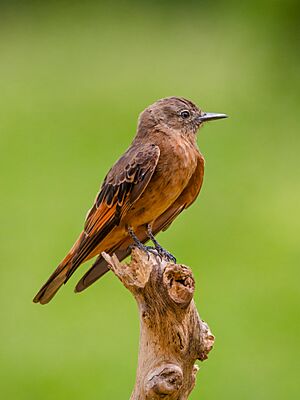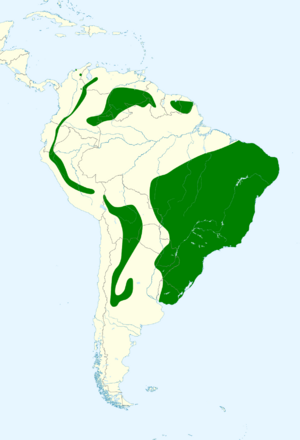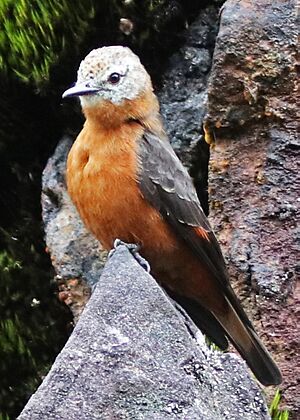Cliff flycatcher facts for kids
Quick facts for kids Cliff flycatcher |
|
|---|---|
 |
|
| In Pindamonhangaba, São Paulo, Brazil | |
| Conservation status | |
| Scientific classification | |
| Genus: |
Hirundinea
|
| Species: |
ferruginea
|
 |
|
| Synonyms | |
|
Hirundinea bellicosa (Vieillot, 1819) |
|
The cliff flycatcher (Hirundinea ferruginea) is a cool bird from the Tyrannidae family, also known as tyrant flycatchers. It's the only type of bird in its group, called Hirundinea. This bird lives in South America. You can find it near cliffs and rocky areas. It also likes forests that are dry, wet, or in the mountains. Sometimes, it even lives in places where forests used to be.
Contents
About the Cliff Flycatcher's Name
The cliff flycatcher got its official name in 1788. A German scientist named Johann Friedrich Gmelin first described it. He called it Todus ferrugineus. This name came from an earlier description by an English bird expert, John Latham. Latham had seen a special bird in a museum in London.
Later, in 1837, two French naturalists, Alcide d'Orbigny and Frédéric de Lafresnaye, created the name Hirundinea for this bird. The name Hirundinea is Latin and means "of swallows." This is because the bird looks a bit like a swallow. The second part of its name, ferruginea, also comes from Latin. It means "rusty-coloured."
Different Types of Cliff Flycatchers
There are four main types, or subspecies, of the cliff flycatcher. They are slightly different depending on where they live:
- H. f. ferruginea: Found in places like eastern Colombia and parts of Brazil.
- H. f. sclateri: Lives from western Venezuela down to southeastern Peru.
- H. f. bellicosa: You can find this one in southern and eastern Brazil, Paraguay, and Argentina.
- H. f. pallidior: This type lives in northern and eastern Bolivia, and parts of Paraguay and Argentina.
What Does the Cliff Flycatcher Look Like?
An adult cliff flycatcher is about 18.5 cm (7.3 in) long. It has a wide beak, which is great for catching insects. Its wings are long and pointed, making it look a bit like a swallow when it flies.
The top part of its body is a dusty brown color. But its lower back and the base of its tail are a bright, rusty red. This color is called rufous. When it flies, you can see the cinnamon-rufous color on its wing feathers. The tips of its wings are dark. Its belly and chest are a pale cinnamon-rufous. It also has some grey spots on its throat.
Where Do Cliff Flycatchers Live?
The cliff flycatcher lives only to the east of the Andes mountains. This means you won't find it in Chile. But you can find it in almost all other countries in South America.
It lives around the edges of the Amazon basin. It also ranges down to central Argentina and across to southern Brazil, Paraguay, and Uruguay. It can even be found along the Atlantic coast of Brazil.
Their Favorite Homes
These birds love to live near cliffs and deep valleys. They also like rocky areas, old quarries, and even road cuttings. In cities, especially in places like São Paulo, they sometimes live on tall buildings. The windowsills and sides of these buildings act like artificial cliffs for them.
Some cliff flycatchers travel, or migrate, to warmer places during certain times of the year. This usually happens with populations living further south. Birds living closer to the equator tend to stay in one place all year.
How Cliff Flycatchers Live
The cliff flycatcher is a very active bird. It likes to sit on a high spot where it can see everything. From there, it flies out to catch insects in the air. It performs amazing aerial displays as it hunts!
When it's time to build a nest, the cliff flycatcher chooses ledges on cliffs. It makes its nest strong by placing small pebbles in a circle around it. This helps to support the nest. In cities, these clever birds have learned to build their nests on the windowsills of tall buildings.



